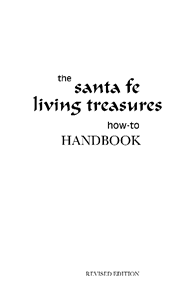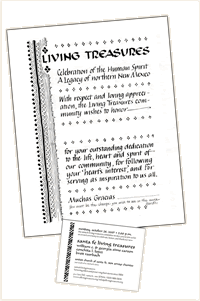 |
Revised edition
©2008 by Santa Fe Living Treasures
Adapted from the original How-to Handbook
by Mary Lou Cook ©1997
_________________________________
TABLE OF CONTENTS
an invitation...
This is our invitation and encouragement for other communities to start a Living Treasure program.
We've put this booklet together as an informal sharing of ideas on creating a Living Treasure program. It represents more than two decades of experiences, successes, and mistakes. You're welcome to use whatever might work for you, including the Living Treasures name.
what is Living Treasures?
Our inspiration is Gandhi's quote, "You must be the change you wish to see in the world."
We see this program as a counterpoint to some of the distressing trends of our times. Our Treasures represent our best values. They are fine role models for all generations, providing inspiration with their good deeds and with their hope, heart, and wisdom.
Adapted from the Japanese tradition of honoring Elders, this program has also been adapted to recognize exceptional people in other groups such as in schools or in churches.
We believe it is important to express gratitude to those who benefit our communities and to bring their stories to the public. We hope you'll want to start a similar program in your community!
gather a committee together
Gather people of positive attitude, those who are enthusiastic, creative and have a special affection for our Elders. Aim for diversity of background and experience, along with competency, compassion, and humor.
This project can be adapted to any budget. There is no paid staff; the committee shares the responsibilities as volunteers. Our reward is immense satisfaction and pleasure in bringing community together around the special people who are our Treasures.
Select a convener, a mutual meeting time and place, and you’re ready to go!
getting organized
Establishing Goals
Establish your own operating procedure. Keep it simple, have fun, be creative, trust yourselves, and learn to listen. There's no right way, no wrong way—there's your way.
Agree on a purpose and write it down. This is your mission statement.
Write a brief description of your project and of the criteria for selecting Living Treasures. Provide this information when you invite written nominations from the community.
The extent of the projects you decide to include in your program will determine the tasks to be accomplished and the people and materials needed to do them.
Minimum Requirements
At the minimum you will need:
- a place to hold the ceremony—it can be as simple as a living room
- a certificate of award to present to the Treasures
- a gathering of family and friends to share the occasion
Committee Roles
The committee roles listed below include the basic tasks followed by additional possibilities.
Committee members can select the jobs that match their own skills and interests. Members may have multiple roles depending on the division of the tasks at hand.
- A convener arranges and facilitates the meetings and perhaps the ceremony as well. Or there can be a separate emcee for the ceremony.
- A secretary takes and maintains meeting notes if wanted. Other tasks may include correspondence and maintaining lists. This person may also serve as archivist (see below).
- A treasurer records and manages all income and expenses, and files any required financial reports.
- An archivist keeps the nomination letters, clippings, photographs, and audio recordings of Living Treasures in files and scrapbooks. This person may also keep the committee records.
- A telephone-relay person receives and relays telephone messages, and may also notify committee members of meetings.
- One or more interviewers record the oral histories of the Treasures.
- A photographer takes portraits of the Treasures for the archive.
- A graphic artist creates a logo, stationery, the award certificate, invitations, and if desired, ceremony programs, name tags, and other printed materials.
- A public relations person writes press releases and communicates with media.
- A videographer—if you can manage it—would film interviews and/or the ceremonies.
- Community Liaison—depending on the projects you are doing, this person would contact local businesses about the donation of funds, services, or venues for Living Treasure events and projects.
things to consider
It doesn't cost a lot to say thank you. This can be a low-budget operation. We pass the hat—a boot actually—at each ceremony, which helps to cover expenses until the next ceremony.
The basic needs include • a place to hold ceremonies • certificates of award • office supplies and postage for correspondence and invitations • a filing system for records.
Beyond that, committee members may pay for, or find donations for, special needs such as: a quality tape recorder for interviewing, photography equipment and supplies, and a telephone listing in the phone book. Further options include making award medals, having an answering service and P.O. Box, and making a video of each Treasure. This can be expensive, but is a valuable addition to the archives. (Our own archives are stored at the local History Library. Your community college may be interested in taking on an ongoing "oral history" video project. Ask them.)
You can encourage local businesses to become involved in your program and invite them to sponsor (or donate to) an event or project.
preparing for the ceremony
Decisions & Tasks
Hold a committee meeting to consider:
- When to hold a ceremony—once or twice a year.
- What day: Saturday or Sunday afternoon (evenings are difficult for Elders).
- Choose a place for ceremony and get confirmation.
- Choose new Treasures from nominating letters. Considerations might include: How their service has benefitted the community and how they have inspired other people. Treasures also have the admirable qualities of kindness, courage, wisdom, grace, authenticity, humor, humility, respectfulness, and generosity of spirit.
- Start a mailing list for invitations if you wish.
- Prepare the invitation and certificate: see “Invitation and Certificate” below.
Contacting the New Treasures
- Convener calls the honoree with news of his/her selection and gives the date, place and time of the Ceremony.
- Convener advises that the honoree will be contacted for a photograph and interview.
- Convener mails basic information about Living Treasures to honoree.
- Photographer makes an appointment and goes to the home or place designated. Obtains a signed release.
- Interviewer makes an appointment and conducts the interview on tape according to committee's standards. Interviewer collects all possible biographical information and makes copies for files and for Treasures. See "Tips for Interviewing."
- Honoree is given invitations to mail and distribute to family and friends.
Tips on Interviewing
- The main purpose is to get the honoree's story through inquiry of values, personal thoughts, memories, attitude and experience. Without this taping, stories can be lost.
- Before the interviewing, learn about the honorees from their friends or family and from the nomination letters and any articles. For questioning skills, study radio and TV interviews.
- At the interview, before recording, put the honoree at ease by talking about something engaging. Adjust the microphone and test the voice and volume. Consider the person’s energy in determining the length of interview. A 30-minute interview may be enough for those who tire easily.
- When starting the tape, clearly give your name, date, place and name of the honoree.
- Be a good listener, be a questioner, keep your own opinions to yourself.
- Divide the honoree's life into three parts: child, youth, and adult.
Start with simple facts: when born, origin of family, circumstances, relatives, memories of childhood, what was their downtown like, education, job, how this shaped who the person is today.
- Optional questions: Your favorite activity? Fun times? Most significant mistake? What would you do differently? What have you learned? What and who inspires you? How do you view yourself? Secret of life? What is your most significant accomplishment? What is your heart's desire?
- Sometimes you must interrupt too lengthy details to complete overall story.
Getting the Word Out
- Submit a well-written press release to the media, allowing ample time for them to prepare any articles or interviews. Include the ceremony date/time/location, details of the honorees, and a clear photo. State that the public is invited.
- Ask for a feature story in the newspaper about the new honorees.
- Send announcements to local magazines and newsletters. "Calendar of Events" are usually free.
- Address invitations and also invite past honorees.
- Additional publicity may include lining up radio and TV interviews, and scheduling presentations about your program at schools and service clubs.
Invitation & Certificate
 Purchase or create an 8 1/2”x 11” certificate. Make a “master” to be copied on good paper such as parchment. Write in the honoree’s name and the date and put it in a certificate frame to be presented at the ceremony. Purchase or create an 8 1/2”x 11” certificate. Make a “master” to be copied on good paper such as parchment. Write in the honoree’s name and the date and put it in a certificate frame to be presented at the ceremony.- Invitations, if used, can be as simple as a postcard, 4 to a sheet, copied on heavy (80-lb.) cover stock. The post cards can be mailed without or with an envelope (size A-2). Consider the cost of postage. Mail to arrive about two weeks before the ceremony.
- We provide invitations to our honorees so that they may send them to friends and family.
- If you keep a mailing list, update it from returned invitations. Add names from the ceremony guest book
the honoring ceremony
- The committee arrives early to set up the room and arrange the seating. The new honorees and past honorees sit in the front rows. If crowded, ask younger people to give their seats to Elders.
- Check for temperature comfort, lighting, and noise factors. Test PA system if using one. Set up any exhibit, guest book, refreshments, etc.
- The convener welcomes the community, ensures that everyone can hear, and gives a brief introduction to the Living Treasures organization.
- The committee and previously-honored Living Treasures are introduced as groups. If the gathering is small, it is nice to ask the Treasures to share any news about their current activities.
- The convener introduces each new Treasure with a brief biographical summary. a family member or friend presents the award, and the new honoree is invited to speak.
- Then family and friends are encouraged to share stories and reminiscences about the honoree. Ask that the stories be brief so that all may contribute who wish to. There are often tears and laughter.
- We “pass the hat” to help cover the costs of printings, mailings, photos, etc.
- At the conclusion of the ceremony, all are invited to enjoy refreshments and to meet the new honorees.
related projects
Projects this important often inspire related ideas.
- This program may be used to honor "treasures" of any age within organizations, schools, or work.
- Share photos of your Treasures by exhibiting them in a public area or gallery. You can provide a guest book for comments.
- We encourage school classes to do oral interviews of their grandparents. We developed "Tips for Interviewing" (included in this booklet) for our committee members and found it has many other uses.
- Treasures are often invited to be on community panels.
- Plant trees in the park to honor a Treasure.
|


 Purchase or create an 8 1/2”x 11” certificate. Make a “master” to be copied on good paper such as parchment. Write in the honoree’s name and the date and put it in a certificate frame to be presented at the ceremony.
Purchase or create an 8 1/2”x 11” certificate. Make a “master” to be copied on good paper such as parchment. Write in the honoree’s name and the date and put it in a certificate frame to be presented at the ceremony.